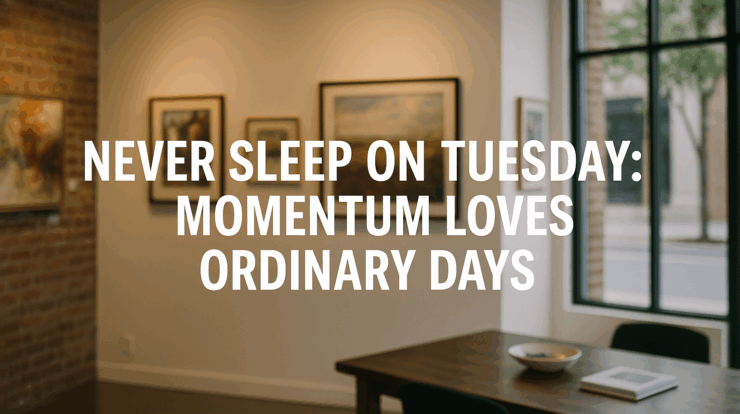
Some days feel like beige paint: nothing flashy, just there. That’s exactly when great things happen.
I’ve lost count of the “ordinary” weekdays that turned into banner art sales days. Not because the planets aligned—because we were ready, visible, and steady. When you treat Tuesdays like showtime, Tuesdays start behaving like Saturdays.

On a recent Tuesday in August—a day when we might expect very little to happen—a couple of long-time clients came in to see a piece they had spotted on our website. That visit turned into a $4,800 purchase. It wasn’t chance; it was the result of preparation, consistency, and staying present, even on a day when expectations were low.
This mindset isn’t just for gallery owners. Artists participating in shows, or those who allow public access to their studios, benefit just as much from treating the quiet days as opportunities.
The Tuesday Mindset
Assume today matters. Big art sales don’t announce themselves. They may look like a casual visit from someone curious about a piece online, or a local who wanders in to see what’s new. Treat every interaction like the door to something larger.
Replace prediction with preparation. You can’t control who shows up; you can control readiness: floor clean, displays fresh, staff prepared, website aligned with in-person inventory.
Momentum is earned in the mundane. Small wins—welcoming a guest, answering an inquiry, confirming shipping details—stack up. They build the rhythm that makes larger sales feel seamless when they arrive.
Be Present: Greet, Observe, Re-engage
Presence beats pressure. The best sales days come from calm attention, not hard sell.
-
Greet early, lightly. A simple opener: “Have you seen my work before?” Nine times out of ten, the answer is no—which gives you a natural chance to share a quick story.
-
Observe, then give space. Watch body language. If someone is revisiting the same piece or referencing a website image, they’re showing buying signals.
-
Re-engage with purpose. Connect their interest to a concrete benefit: the story of the piece, how it would look in their space, or the ease of arranging delivery.
The 75/25 conversation rule. Let visitors do most of the talking. Guide with questions like:
-
“What caught your attention about this piece online?”
-
“Where are you picturing it in your home?”
-
“Would it help to see framing or size options?”
When they talk, you learn. When you learn, you help. When you help, you sell.
Treat Every Visitor as a Buyer
It’s tempting to divide people into “buyers” and “lookers.” Don’t. The couple who came in that August Tuesday were specifically there to see one artwork—and left with it. That’s the reminder: every visitor deserves full attention.
Practical ways to stay open-handed:
-
Show related works. If they came for one piece, show them others in the same series or medium.
-
Offer shipping and installation as part of the conversation. Clarity builds confidence.
-
Keep price integrity. When someone has already visualized a piece in their life, confidence in your pricing reinforces their decision.
Small Wins Stack
You won’t manufacture a $4,800 sale by sheer willpower. You will earn it by having the fundamentals ready.
Stackable habits:
-
Refresh the space daily. Details matter—sightlines, lighting, labels.
-
Prep re-engagement lines. Example: “Would you like to see how this looks in a larger scale?”
-
Keep online and in-person inventory synced. Many visits begin online, so the handoff must be seamless.
-
Make smalls visible. Prints, cards, and small originals invite first-time buyers into the collector journey.
Proof Lives in the Boring Parts
On paper, Tuesday is forgettable. In practice, it’s a test of discipline: how we greet, what we notice, how we re-engage, and whether we’re ready when someone walks in to claim the piece they’ve already been imagining in their home.
Treat every day like that, and you stop waiting for momentum—you build it. Sometimes it shows up as a modest string of receipts. Sometimes it’s the unexpected $4,800 that reshapes your month.
Either way, don’t sleep on Tuesday. It’s where the quiet work pays off.
